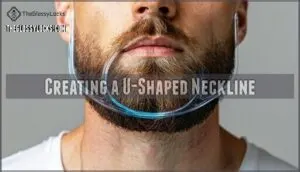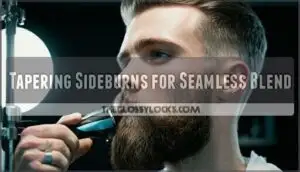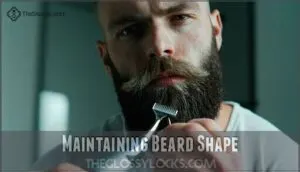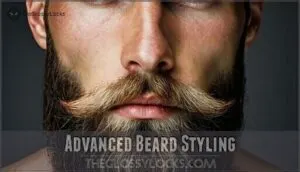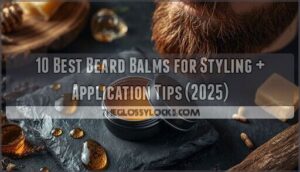This site is supported by our readers. We may earn a commission, at no cost to you, if you purchase through links.
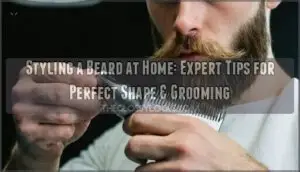
Start by identifying your face shape—it’s your roadmap to choosing flattering styles. Use adjustable trimmers with longer guards first, working down gradually. Think of it like sculpting marble: you can’t add back what you’ve cut.
Define clean cheek lines by following your natural growth pattern, then create a U-shaped neckline about two fingers above your Adam’s apple. Trim sideburns to blend seamlessly with your haircut.
The secret isn’t expensive equipment—it’s patience and steady hands. Master these fundamentals, and you’ll discover advanced techniques that transform your everyday grooming routine.
Table Of Contents
- Key Takeaways
- Choosing Beard Styles
- Beard Trimming Techniques
- Shaping Beard Lines
- Maintaining Beard Shape
- Advanced Beard Styling
- Frequently Asked Questions (FAQs)
- How can I style my beard myself?
- What is the 3 month beard rule?
- What is the rule 5 for beards?
- What is the two finger rule for beard?
- What products should I use for beard care?
- How often should I wash my beard?
- Can I fix patchy or uneven beard growth?
- What tools are essential for home beard grooming?
- How do I deal with beard dandruff?
- Conclusion
Key Takeaways
- Start with your face shape as your blueprint – You’ll choose the right beard style by identifying whether you have a round, square, oval, or triangular face, then selecting styles that balance your natural features rather than fighting against them.
- Use the "sculpting marble" approach when trimming – You can’t add back what you’ve cut, so start with longer guard settings and work down gradually, taking small amounts over several sessions rather than trying to achieve perfection in one go.
- Master the essential lines for a professional look – You’ll create clean cheek lines following your natural growth pattern and establish a U-shaped neckline about two fingers above your Adam’s apple to avoid the "neckbeard" appearance.
- Maintain consistency with regular upkeep – You’ll keep your beard looking sharp by trimming every 5-7 days, using quality tools with adjustable guards, and focusing on symmetry rather than perfection to build confidence over time.
Choosing Beard Styles
Your face shape acts like a blueprint for finding the perfect beard style, much like how a tailor measures before cutting fabric.
You’ll discover that round faces need length at the chin while square faces benefit from softer, curved edges that balance those strong jawlines.
Face Shape Considerations
Your face shape is the roadmap to perfect beard styling.
Your beard isn’t just facial hair—it’s your personal signature carved in whiskers.
Round faces need beard length on the chin to create jawline emphasis, while square faces benefit from circular styles that soften sharp angles.
Oval faces allow style experimentation with any beard styles.
Consider facial proportions and hairstyle pairing when selecting your look—understanding face geometry and facial structure transforms your beard shaping approach.
Geometric Principles for Beard Styling
Understanding face shape geometry transforms your beard game from guesswork to precision.
Your facial structure dictates which beard style ratios work best, creating natural symmetry and styling that enhances your features.
Here are five geometric principles that’ll revolutionize your beard boundaries:
- Square faces need circular softening – round out those sharp angles
- Long faces require width – build horizontal volume for balance
- Round faces demand length – elongate with strategic beard contrasts
- Triangle faces benefit from upper fullness – proportional beard design adds width
- Oval faces accommodate most styles – lucky you, angle customization is yours
Beard Trimming Techniques
Once you’ve picked your perfect beard style, it’s time to master the art of trimming. Think of beard trimming techniques like sculpting—you’re removing excess to reveal the masterpiece underneath.
Hedge Trimming works best for most beards. Start with longer guard settings and work shorter, removing flyaway hairs while maintaining bulk. This beard trimming guide prevents those dreaded trimming mistakes that leave you looking lopsided.
Here’s your beard shaping at home roadmap:
| Step | Technique |
|---|---|
| Start High | Use longest guard setting first |
| Work Down | Gradually decrease guard length |
| Check Often | Stop and assess every few passes |
| Focus Symmetry | Compare both sides constantly |
| Clean Edges | Save detail work for last |
Tool Investment matters—quality trimmers with adjustable guards give you control. Remember, Symmetry Focus beats perfection. Your beard grows back, but confidence takes longer to restore after a trimming disaster.
Shaping Beard Lines
Shaping your beard lines transforms a decent beard into a sharp, professional look that frames your face perfectly.
You’ll master three key techniques: defining clean cheek borders, creating that essential U-shaped neckline, and tapering your sideburns so they blend seamlessly with your hairline.
Defining Clear Borders Around Cheeks
Sharp cheek lines make or break your beard’s overall appearance.
Your cheek lines are the difference between looking sharp and looking sloppy—get them right.
Start by identifying your natural cheeklines—don’t fight Mother Nature if hair grows sparsely.
For dense growth, use tapering techniques with your trimmer to create subtle density adjustments.
Focus on symmetry considerations by checking both sides frequently.
When shaping beard cheek line at home, embrace natural cheek lines rather than creating artificial borders that look unnatural.
Creating a U-Shaped Neckline
After establishing clean cheek borders, your beard neckline placement becomes the foundation of professional grooming.
The U-shape depth should start behind each ear, creating a gentle curve that peaks about 1.5 inches above your Adams apple. This strategic positioning prevents that dreaded "neckbeard" look while maintaining cleanliness through proper fading techniques.
To achieve this look, you may need a neckline shaving guide.
- Visualize the U-curve – Imagine drawing a smile under your jaw, connecting ear to ear with the lowest point above your Adams apple
- Use the two-finger rule – Place two fingers above your Adams apple to find the perfect neckline placement depth
- Trim conservatively first – Start with longer guard settings when shaping beard cheek line, then gradually go shorter to avoid overcutting mistakes
- Maintain symmetry – Check both sides frequently in the mirror to confirm your beard neckline matches perfectly on each side
- Clean up daily – Quick touch-ups with your beard trimming guide prevent stray hairs from ruining your carefully crafted U-shaped boundary
Tapering Sideburns for Seamless Blend
Your U-shaped neckline looks sharp, but sideburns can make or break the whole look.
Tapering sideburns creates that seamless blend between your head hair and beard. Start with a longer guard setting, gradually shortening as you work down.
This blending technique guarantees smooth facial hair shift. Think of it like creating a gentle slope rather than a cliff—your sideburn length should flow naturally into your beard styling masterpiece, ensuring a seamless transition with smooth facial hair.
Maintaining Beard Shape
Once you’ve shaped your beard, you’ll need to stay on top of regular maintenance to keep it looking sharp and professional.
This maintenance is crucial because it prevents wild growth and keeps everything neat, much like maintaining a hedge in your yard.
Consistent trimming and the use of precision tools help you refine those edges that make all the difference.
Regular Trimming for Neatness
Once you’ve shaped your beard lines, regular beard trimming becomes your secret weapon for maintaining that fresh look.
Think of it like mowing your lawn – consistent upkeep prevents wild growth and keeps everything looking intentional.
Here’s why consistent beard maintenance matters:
- Confidence boost – A well-trimmed beard makes you feel put-together
- Professional appearance – Regular upkeep shows attention to detail
- Easier styling – Consistent trimming prevents unruly, stubborn patches
- Growth guidance – Regular sessions help train your beard’s natural pattern
The hedge trimming approach works best for uniform shaping. Start with longer guard settings and work shorter to avoid overcutting – remember, you can always trim more, but you can’t put hair back.
When correcting mistakes, take small amounts over several days rather than trying to fix everything at once.
Using Trimmers With Adjustable Guards
Once you’ve established your trimming routine, adjustable guards become your best friend for consistent results.
Start with longer guard lengths and work shorter – you can always trim more, but you can’t put hair back.
Your beard trimmer’s guards control everything from basic maintenance to advanced blending techniques.
| Guard Number | Length (mm) | Best For |
|---|---|---|
| #1 | 3mm | Close fade work |
| #2 | 6mm | Short beard maintenance |
| #3 | 9mm | Medium length styling |
| #4 | 12mm | Longer beard shaping |
| #5 | 15mm | Initial bulk removal |
Master these beard guard settings for foolproof tapering beards without the usual rookie mistakes that leave you looking lopsided.
Refining Edges With Precision Tools
After establishing your beard’s basic shape, precision trimming becomes your secret weapon for professional results.
Use a guardless trimmer or sharp razor for edge definition around your neckline and cheeks. Master symmetry techniques by working one side, then mirroring the other.
A quality trimming device is essential for achieving the best results.
Tool maintenance keeps blades sharp, avoiding mistakes that come from dull equipment pulling hairs instead of cutting cleanly, which is crucial for a professional look and requires a quality trimming device.
Advanced Beard Styling
You’ve mastered the basics, but advanced beard styling is where your facial hair transforms from decent to downright impressive.
This is where you’ll customize your beard to match your unique facial structure, enhance your natural lines with precision trimming, and achieve that fuller, perfectly groomed look.
That makes people wonder if you’ve got a secret barber hiding in your bathroom.
Customizing Styles Based on Facial Structure
Once you’ve mastered regular trimming, customizing your beard style becomes the real game-changer.
Your face shape guide determines everything—round faces need length, square faces require softening curves.
Achieving beard symmetry means working with your natural facial structure, not against it.
Feature enhancement through proportional balance creates unique looks that complement your bone structure perfectly, and this is where customizing your beard style can make a significant difference.
Enhancing Natural Lines With Trimmers
Once you’ve matched your beard to your face shape, it’s time to work with what nature gave you. Your natural beard lines aren’t flaws—they’re your foundation.
Smart trimmer work can turn those lines into sharp, defined edges that look intentional.
Here’s how to enhance your natural lines with precision:
- Start with longer trimmer guards and gradually decrease length to avoid overcutting disasters
- Follow your natural cheek line instead of fighting it—use tapering for dense growth areas
- Create subtle fades along your neckline using different guard lengths for professional results
- Refine edges with a guardless trimmer for crisp, barbershop-quality definition
- Embrace your growth pattern and enhance it rather than forcing unnatural shapes.
Selecting the right trimmer guard sizes is essential for achieving consistent results.
Achieving a Fuller and Well-Groomed Appearance
Once you’ve mastered enhancing natural lines, the next step focuses on maximizing beard density and overall presentation.
Strategic styling products like thickening balm can transform patchy growth into a fuller appearance.
Your daily grooming routine should include blow-drying upward for volume and conditioning for hair health.
These proven beard styling techniques create the well-groomed look you’re after.
Frequently Asked Questions (FAQs)
How can I style my beard myself?
Picture your friend Jake turning his scraggly lockdown beard into a sharp, professional look using just bathroom scissors and a $20 trimmer.
You’ll need quality tools, patience, and technique to transform your facial hair yourself.
What is the 3 month beard rule?
The three-month beard rule means you don’t trim or shape your beard for three full months, letting it grow naturally. This reveals your beard’s true potential and growth patterns.
What is the rule 5 for beards?
Looking for that perfect fade technique?
Rule 5 states you should trim your beard every five to seven days to maintain shape and prevent uneven growth patterns from ruining your carefully crafted style.
What is the two finger rule for beard?
The two finger rule helps you find your beard’s natural neckline.
Place two fingers above your Adam’s apple – that’s where your natural neckline should sit.
Everything below gets trimmed for clean definition.
What products should I use for beard care?
You’d think beard care requires a pharmacy’s worth of products, but you really only need three essentials: quality beard oil for moisture, a good trimmer with guards, and a boar bristle brush for distribution and styling.
This sentence forms a complete concept, and there are no other ideas or sentences to group.
How often should I wash my beard?
You should wash your beard 2-3 times per week with a gentle beard shampoo.
Daily washing strips natural oils, causing dryness and irritation.
Let your skin’s natural oils work their magic between washes.
Can I fix patchy or uneven beard growth?
Picture yourself staring at a patchy canvas in the mirror.
You can’t completely fix genetics, but strategic trimming, patience, and beard oils help disguise gaps while encouraging growth in sparse areas.
What tools are essential for home beard grooming?
You’ll need a quality trimmer with adjustable guards, sharp scissors for precision cuts, a fine-tooth comb, beard oil or balm, and a handheld mirror. These essentials give you complete control.
How do I deal with beard dandruff?
Don’t let flaky skin rain on your parade.
Wash your beard twice weekly with anti-dandruff shampoo, moisturize with beard oil daily, and gently exfoliate using a boar bristle brush to remove dead skin cells.
Conclusion
Mastering the art of facial hair maintenance transforms your daily routine from chore to craft.
You’ve learned that styling a beard at home isn’t rocket science—it’s about understanding your face, respecting your natural growth patterns, and wielding your trimmer with confidence.
Remember, even barbers started somewhere, and your mirror won’t judge your early attempts.
With these techniques in your grooming arsenal, you’ll craft a beard that commands respect and turns heads wherever you go, making you a master of your own style.


